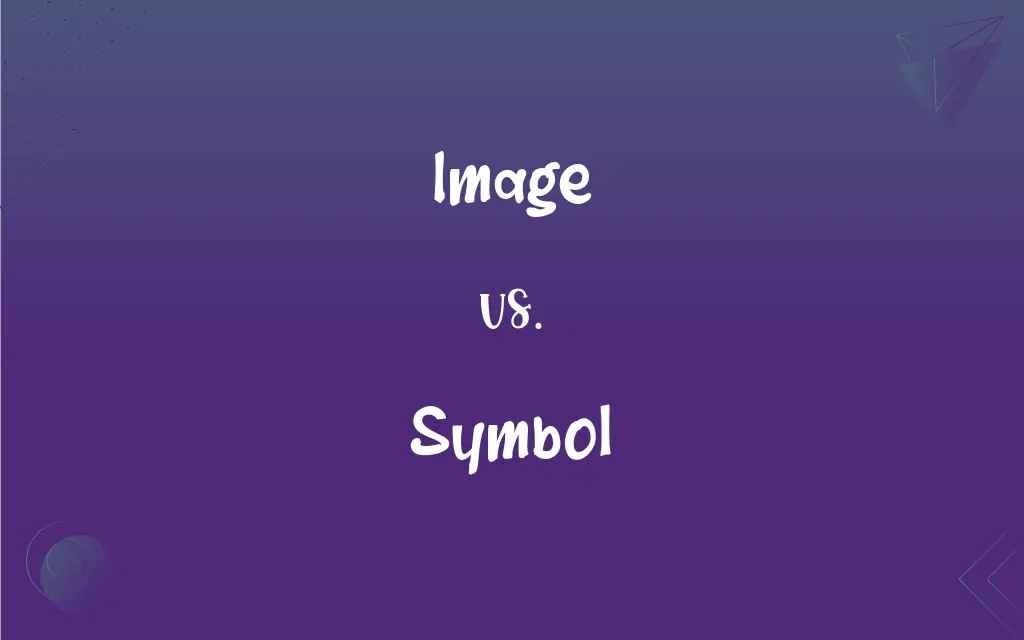Image vs. Symbol: What's the Difference?
Edited by Janet White || By Harlon Moss || Updated on November 6, 2023
An image is a visual representation of an object, while a symbol is a sign or object that represents an idea, process, or physical entity.

Key Differences
An image is a likeness or representation of someone or something, often produced through photography, painting, or other artistic processes. A symbol, however, is a mark, sign, word, or phrase that signifies an idea or entity and carries meaning beyond its mere appearance.
Images capture the appearance of their subjects and can be realistic or abstract. Symbols, in contrast, are not intended to be realistic but to suggest particular meanings or associations, like the dove as a symbol of peace.
The role of an image is often to depict or illustrate, serving as a visual representation in contexts ranging from art to science. Symbols are used to convey ideas, principles, or identities, such as national flags symbolizing countries.
Images can invoke immediate recognition or emotional response due to their visual similarity to their subject. Symbols require a learned or culturally understood context to be interpreted, like the caduceus symbolizing medicine.
While images can stand alone as complete entities, symbols often are part of a larger system of language or signs, such as religious iconography or mathematical notation, where each symbol is defined in relation to others.
ADVERTISEMENT
Comparison Chart
Definition
Visual representation of something.
A sign that represents something else.
Function
To depict or illustrate.
To signify ideas or concepts.
Interpretation
Often direct and straightforward.
Requires cultural or contextual knowledge.
Dependency
Can be independent of cultural context.
Often dependent on cultural context.
Use
In art, media, and documentation.
In communication, mathematics, and symbols.
ADVERTISEMENT
Image and Symbol Definitions
Image
The concept of a person, group, or company presented to the public.
The celebrity's image was carefully curated by her management team.
Symbol
A thing that represents or stands for something else, especially a material object representing something abstract.
The national flag is a symbol of the country and its people.
Image
A physical likeness or representation of a person, animal, or thing, photographed, painted, sculptured, or otherwise made visible.
The artist captured her image perfectly in the portrait.
Symbol
A letter, figure, or other character or mark or a combination of letters or the like used to designate something.
The symbol 'H' is the chemical element for hydrogen.
Image
An optical counterpart or appearance of an object, as is produced by reflection from a mirror.
He adjusted the mirror to see his image.
Symbol
Something used for or regarded as representing something else.
The dove is a symbol of peace.
Image
A mental representation; an idea or conception.
She had a clear image of how she wanted her wedding to be.
Symbol
An action, object, event, etc., that expresses or represents a particular idea or quality.
A chain can be a symbol of unity or imprisonment.
Image
A character or reputation, as the public perceives it.
The company is trying to improve its image.
Symbol
A written or printed sign that represents something in a particular context, such as a language or field of study.
In mathematics, 'π' is the symbol for pi.
Image
A representation of the form of a person or object, such as a painting or photograph.
Symbol
Something that represents something else by association, resemblance, or convention, especially a material object used to represent something invisible
The lamb is a symbol of innocence.
Image
A sculptured likeness.
Symbol
An instance that typifies a broader pattern or situation
His striking out to end the rally was a symbol of everything that had gone wrong with the team over the past month.
FAQs
Are images used in branding?
Yes, images are crucial in branding to create visual identity.
Do symbols have fixed meanings?
Some symbols have universally agreed-upon meanings, while others can vary by culture or context.
Can an image be abstract?
Yes, images can be abstract, representing subjects in non-literal ways.
Do symbols need to be visual?
Primarily they are visual, but symbols can also be auditory, like a whistle symbolizing a foul in sports.
Can an image itself be symbolic?
Yes, images can carry symbolic meaning, like a dark cloud image symbolizing gloom.
How do images affect memory?
Images can improve memory recall by creating visual associations.
Is a photograph always considered an image?
Yes, photographs are a common form of images.
Can a symbol be a word?
Yes, words can function as symbols in various contexts.
Are emojis considered symbols?
Yes, emojis are symbols that represent emotions, objects, or concepts.
Can an image be iconic?
Yes, some images become iconic, recognized widely and representing significant cultural moments.
What makes an image powerful?
An image can be powerful due to its emotional impact, subject matter, or aesthetic quality.
Can symbols be patented?
Yes, symbols used as logos or trademarks can be legally protected.
Is image quality subjective?
Yes, perceptions of image quality can be subjective, based on personal or cultural standards.
Are mathematical notations symbols?
Yes, mathematical notations are symbols that represent numbers, operations, and relations.
Is punctuation a form of symbols?
Yes, punctuation marks are symbols used to clarify the meaning of written language.
Can a color be a symbol?
Yes, colors can serve as symbols, like red symbolizing love or danger.
Is a flag a symbol?
Yes, a flag is a symbol representing a country, organization, or movement.
Are images more impactful than text?
Images can be more immediately impactful due to visual appeal, but text has its own strengths in communication.
What is the role of images in education?
Images aid in visualization and enhance learning by providing visual context.
Can symbols evolve over time?
Yes, the meaning of symbols can evolve as cultural and societal norms change.
About Author
Written by
Harlon MossHarlon is a seasoned quality moderator and accomplished content writer for Difference Wiki. An alumnus of the prestigious University of California, he earned his degree in Computer Science. Leveraging his academic background, Harlon brings a meticulous and informed perspective to his work, ensuring content accuracy and excellence.
Edited by
Janet WhiteJanet White has been an esteemed writer and blogger for Difference Wiki. Holding a Master's degree in Science and Medical Journalism from the prestigious Boston University, she has consistently demonstrated her expertise and passion for her field. When she's not immersed in her work, Janet relishes her time exercising, delving into a good book, and cherishing moments with friends and family.































































